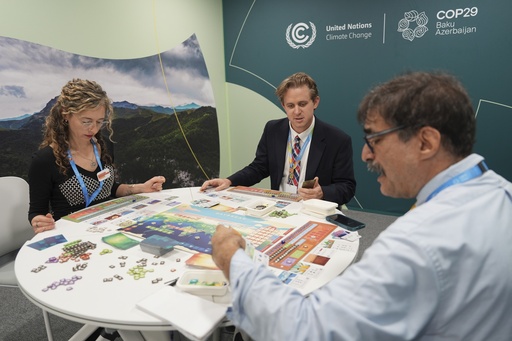
BAKU, Azerbaijan — Advocates and specialists striving to persuade global authorities to address the escalating climate crisis recently discovered that enacting change is challenging, even in a constructed environment.
Aboard the United Nations climate negotiations, a board game called Daybreak was introduced, allowing participants from three nations to engage in a cooperative effort to tackle climate change, which stems from greenhouse gas emissions produced by the burning of fuels like gasoline, natural gas, and coal. The primary objective was to prevent the global temperature from rising too high and to avoid catastrophic extreme weather events.
Participants took turns embodying roles representing the United States, China, Europe, and other regions, grappling with various weather catastrophes while attempting to lower emissions through initiatives such as restoring wetlands and opposing fossil fuel interests—a task dictated by the cards drawn.
The crisis cards, characterized by yellow and red, posed the greatest setbacks. Each round introduced a new challenge, exemplified by a card titled “Storms,” which mandated participants to add a “Community in Crisis” for every rise in temperature of 0.1 degrees Celsius (0.2 degrees Fahrenheit), or another card indicating “Sea Level Rise,” which resulted in a loss of “Infrastructure Resilience.”
Counteracting these challenges are blue cards representing local initiatives, like improvements in fertilizer efficiency, which allow players to subtract a methane-emitting livestock token, or the introduction of public transport, which helps eliminate a token linked to automotive emissions.
In every match played, the temperature surpassed the upper limit established during the 2015 Paris Agreement, pegged at 1.5 degrees Celsius (2.7 degrees Fahrenheit) above pre-industrial levels. Technically, the game remains in play until hitting a 2 degrees Celsius (3.6 degrees Fahrenheit) mark. However, reaching the 1.5-degree mark left players disheartened as they faced their fictional world spiraling beyond this critical threshold.
During the second round, lasting about 20 minutes, participants noted that the global temperature had already climbed to 1.45 degrees Celsius (2.61 degrees Fahrenheit). Borami Seo, the head of food and agriculture at Solutions for Our Climate in South Korea, who represented Europe, expressed disbelief at the rapid escalation of temperatures. “How did that happen? It happened so quickly,” she remarked.
She had hoped to play a pivotal role in aiding others as Europe is seen as a leader in climate initiatives, yet felt incapacitated. “I thought this game was supposed to give us hope. I’m not gaining any hope,” she said, balancing curiosity and frustration in her tone.
The initial two matches faced interruptions for the participants, given the busy agenda of climate discussions, but the third match lasted longer, optimizing the strategy over 47 minutes with three rounds. Jake Schmidt from the Natural Resources Defense Council played the role representing the “majority of the world” when a hurricane struck as temperatures reached 1.8 degrees Celsius (3.2 degrees Fahrenheit). For every 0.1-degree rise beyond 1.2 degrees Celsius, players had to denote additional “communities in crisis.”
Schmidt’s challenges mounted, exceeding the permitted amount of cities facing crises in the game. “All my communities are gone,” he lamented, marking their defeat. “I’m sad. We very quickly got toast. That was only three rounds and my communities were toast,” he stated, adding that perhaps the game could start at a lower temperature.
The game kicks off at a baseline temperature of 1.2 degrees Celsius (2.2 degrees Fahrenheit) higher than pre-industrial figures, whereas the real world is currently at 1.3 degrees Celsius (2.3 degrees Fahrenheit), according to the UN. Schmidt reflected on the difficulty of reducing emissions and found the game environment to be a stark reminder of the daunting challenges posed by climate change.
Matt Leacock, the game’s co-designer and creator of Pandemic, asserted the game’s intention of making participants grapple with the urgent need for collective action against climate change. “I wouldn’t want most people to win the first time they play. I don’t think that’s a productive message. I want players to learn from their experience and want to return to the game with newfound strategies,” he explained.
Leacock underscored the political undertone of the game, stressing that while preventing catastrophic temperature increases is possible, it necessitates decisive early intervention—advice echoed by experts in actual climate discussions. Leacock crafted this game amid the pandemic lockdown to transform what many deem an existential threat into a cooperative endeavor aimed at fostering actionable plans.
In the first game, Jennifer Howard from the Global Climate and Health Alliance experienced the rising tensions as disasters unfolded and global temperatures climbed. “You feel the anxiety rising as you’re getting farther away from your goal and the crisis points are increasing,” she noted.
Howard played the role of the United States, aiming to support Nathan Cogswell from the World Resources Institute, who embodied the majority of the world’s struggles. Upon receiving a “debt reparations” card, she felt compelled to assist Cogswell, stating, “I feel very guilty for my historical emissions,” acknowledging that the U.S. has been the largest contributor of emissions globally.
Cogswell, representing developing nations, accepted the offer, and Howard contributed both political and health insights to their narrative. “I’m feeling like this real glow of goodwill,” she reflected, celebrating the benefits of giving, while ultimately, they could not avert disaster—this time around.
